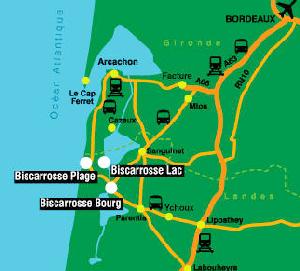 |
| The Independent Traveler's Newsletter PAGE THREE |
 |
| The Independent Traveler's Newsletter PAGE THREE |
| Biscarrosse continued . . . | |
|
Eventually, it became cheaper to import pine resin than to tap the local 'Golden Trees', and things economic began to look bleak. That's where aviation came in -- seaplanes, to be precise. On March 28, 1910, one Henri Fabre (appropriately married to a descendent of the Montgolfier ballooning family) coaxed a heavier-than-air hydro-aéroplane, simply called "Duck" and of which Rube Goldberg would have been jealous, off a Biscarrosse lake. He thus beat the American Curtiss for the first-ever seaplane flight by just a few months. Today, the municipal Seaplane Museum (video in English and guided visits in English for groups of at least ten) vividly documents the evolution since then of French hydraviation, which had its main base on one of the town's huge lakes -- eleven kilometers long and looking more like an inland sea than a pond. Reasons for that choice? A fairly windless context, thanks to those pines, and fresh water which is less damaging to steel than the briney. The museum's email address is musee.hydraviation@ville-biscarrosse.fr.
Air France set up shop here in 1933. In those days, and until Lockheed launched its land-based Constellation in the early 1950s, a well-heeled Parisian could take a first class train to Bordeaux, whence a limousine whisked him to Biscarrosse. A luxurious Latécoère seaplane (remember Flying Down to Rio?) then conveyed him in succession to Casablanca (Morocco), Dakar (Senegal), Natal (Brazil), Fort de France (Martinique), and Pensacola, Florida, thereafter delivering him, perhaps not quite as fresh as a daisy, to New York City. No wonder, then, that an "Air Park" modeled on such American predecessors as Spruce Creek, Florida, and Cameron Park, California, is being built near the Biscarrosse Aéroclub. The principle is simple: you have a 'garage' for your plane as well as your car and direct access to the runway. Pie in the sky? Eh non, thirty seven lots have already been sold! Aside from the dunes, land here is flat, and you can hike through the pines on no less than 150 kilometers of signposted trails, and bike (rentals available) on 30 kilometers of special lanes. There is also year-round horseback riding and dinghy sailing, not to forget orienteering courses and, if like me you're not well heeled enough to have your own plane, an Adventure Park that lets you take several safety-harnessed meters into the air on rope, bungy and so on.  Here
is some helpful contact information:
Arthur Gillette
contributed this article on the Atlantic coastal town of Biscarrosse. Arthur's
Paris Through the Ages Strolls, now numbering 14,
Featuring: the Tarn Each visitor to France's countryside has a favorite destination. Some prefer the mountains and others the coast. There are those who head right for Provence or to wine country. Many Europeans and Americans are settling in France or buying second homes there. France has become a magnet for people from other countries who want to own a piece of this paradise. However, some places remain somewhat more French than others, and we believe that the Tarn is one of those places. We discovered the département of the Tarn, in the Midi-Pyrénées region of southwestern France, many years ago and were very pleasantly surprised. Our goal at the time was to learn more about the birthplace of Henri Toulouse-Lautrec and to visit 'his' museum. In doing so, we had the pleasure of waking in the misty mornings to the sounds of song birds and nothing else. We enjoyed pleasant drives on less-traveled byways and found that even the busy city of Albi was easy to get into and out of, something not always true of French cities. We hope you enjoy sharing with us our visit to the Tarn. We arrived in the Tarn from the north, from the département of Aveyron, having caught the tip of the Gorges du Tarn on the N88 even further north near Florac in the Lozère - a sinuous and breathtaking drive with stupendous views. Our night was spent in a distinguished chambres d'hôtes at the border between the Tarn and Aveyron départements -- a place located deep in a gorge with a trout stream running under a little bridge that led from the parking area to the main entrance. Most of the guests were Germans who had driven there in their own cars and had been there before. They returned year after year for the same charm and ambiance -- and isolation -- that we found so appealing. We loved it and are sad to say that business declined with the economy of both countries, and they have closed their doors. In the
morning, after a wonderful breakfast, we crossed into the Tarn on the N88
over the Gorges du Viaur. The area is dotted with small rivers with names
like Céret, Cérou and Céroc, and the first large town
you come upon is Carmaux, but the highway slices through it with little
notice, and you are on your way to Albi
about 16 kilometers further along the route.
We found the cathedral unique and interesting. From its tall, stark exterior to its overwhelming and ornate interior - actually quite a beautiful interior - it was so different from anything we had seen in France before or since that it will not be forgotten. No expense was spared on the Cathédrale de Sainte-Cécile, and it says to you, "I will be here forever!" The interior can, and probably will, leave you speechless. Decorated by painters from Bologna in Italy and sculptors from Burgundy, it is rich with frescoes and intricate carvings -- and in pristine condition.
|